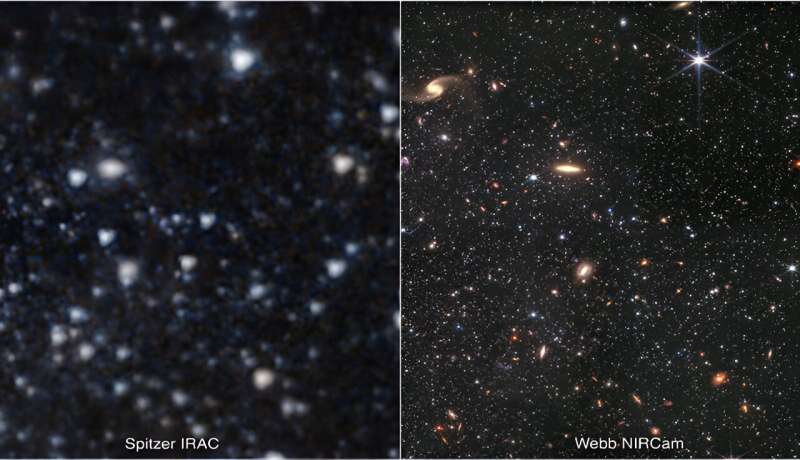This article has been reviewed according to Science X's editorial process and policies. Editors have highlighted the following attributes while ensuring the content's credibility:
fact-checked
peer-reviewed publication
trusted source
proofread
A long, long time ago in a galaxy not so far away: Research unearths clues to conditions of the early universe

Employing massive data sets collected through NASA's James Webb Space Telescope, a research team led by a Rutgers University–New Brunswick astronomer is unearthing clues to conditions existing in the early universe.
The team has catalogued the ages of stars in the Wolf–Lundmark–Melotte (WLM) galaxy, constructing the most detailed picture of it yet, according to the researchers. WLM, a neighbor of the Milky Way, is an active center of star formation that includes ancient stars formed 13 billion years ago.
"In looking so deeply and seeing so clearly, we've been able to—effectively—go back in time," said Kristen McQuinn, an assistant professor in the Department of Physics and Astronomy in the School of Arts and Sciences, who led the research, described in The Astrophysical Journal. "You're basically going on a kind of archaeological dig, to find the very low mass stars that were formed early in the history of the universe."
McQuinn credited the Amarel high-performance computing cluster managed by the Rutgers Office of Advanced Research Computing for enabling the team to calculate the galaxy's history of stellar development. One aspect of the research involved taking one massive calculation and repeating it 600 times, McQuinn said.
The major computation effort also helped confirm telescope calibrations and data processing procedures that will benefit the wider scientific community, she added.
So-called "low mass" galaxies are of special interest to McQuinn. Because they are believed to have dominated the early universe, they allow researchers to study the formation of stars, the evolution of chemical elements and the impact of star formation on the gas and structure of a galaxy. Faint and spread across the sky, they constitute the majority of galaxies in the local universe. Advanced telescopes such as the Webb are allowing scientists a closer look.
WLM—an "irregular" galaxy, meaning it doesn't possess a distinct shape, such as a spiral or ellipse—was discovered by the German astronomer Max Wolf in 1909 and characterized in greater detail in 1926 by Swedish astronomer Knut Lundmark and British astronomer Philibert Jacques Melotte. It is positioned at the outskirts of the Local Group, a dumbbell-shaped group of galaxies that includes the Milky Way.
Being at the edge of the Local Group has protected WLM from the ravages of intermingling with other galaxies, leaving its star population in a pristine state and useful for study, McQuinn noted. WLM also is interesting to astronomers because it is a dynamic, complex system with lots of gas, enabling it to actively form stars.
To formulate the galaxy's star formation history—the rate at which stars have been born across different epochs of time in the universe—McQuinn and her team employed the telescope to painstakingly zero in on swaths of sky containing hundreds of thousands of individual stars. To determine the age of a star, they measured its color—a proxy for temperature—and its brightness.
"We can use what we know about stellar evolution and what these colors and brightnesses indicate to basically age the galaxy's stars," said McQuinn, adding the researchers then counted the stars of different ages and mapped out the birth rate of stars over the history of the universe. "What you end up with is a sense of how old this structure is that you're looking at."
Cataloging the stars in this way showed the researchers that WLM's star-producing abilities ebbed and flowed over time. The team's observations, which confirm earlier assessments by scientists using the Hubble Space Telescope, show that the galaxy produced stars early in the history of the universe over a period of 3 billion years. It paused for a while, then reignited.
McQuinn said she believes that the pause was caused by conditions specific to the early universe.
"The universe back then was really hot," she said. "We think the temperature of the universe ended up heating the gas in this galaxy, and kind of turned off star formation for a while. The cool down period lasted a few billion years and then star formation proceeded again."
The research is part of NASA's Early Release Program, where designated scientists work with the Space Telescope Science Institute and conduct research designed to highlight Webb's capabilities and help astronomers prepare for future observations.
NASA launched the Webb telescope in December 2021. The large-mirrored instrument orbits the sun a million miles away from Earth. Scientists compete for time on the telescope to study a host of topics including the conditions of the early universe, the history of the solar system, and the search for exoplanets.
"There's a lot of science that's going to come out of this program that hasn't been done yet," McQuinn said.
Other Rutgers researchers on the study included Max Newman, a doctoral student, and Roger Cohen, a postdoctoral associate, both in the Department of Physics and Astronomy, Rutgers School of Arts and Sciences.
More information: Kristen. B. W. McQuinn et al, The JWST Resolved Stellar Populations Early Release Science Program. IV. The Star Formation History of the Local Group Galaxy WLM, The Astrophysical Journal (2024). DOI: 10.3847/1538-4357/ad1105
Journal information: Astrophysical Journal
Provided by Rutgers University





















